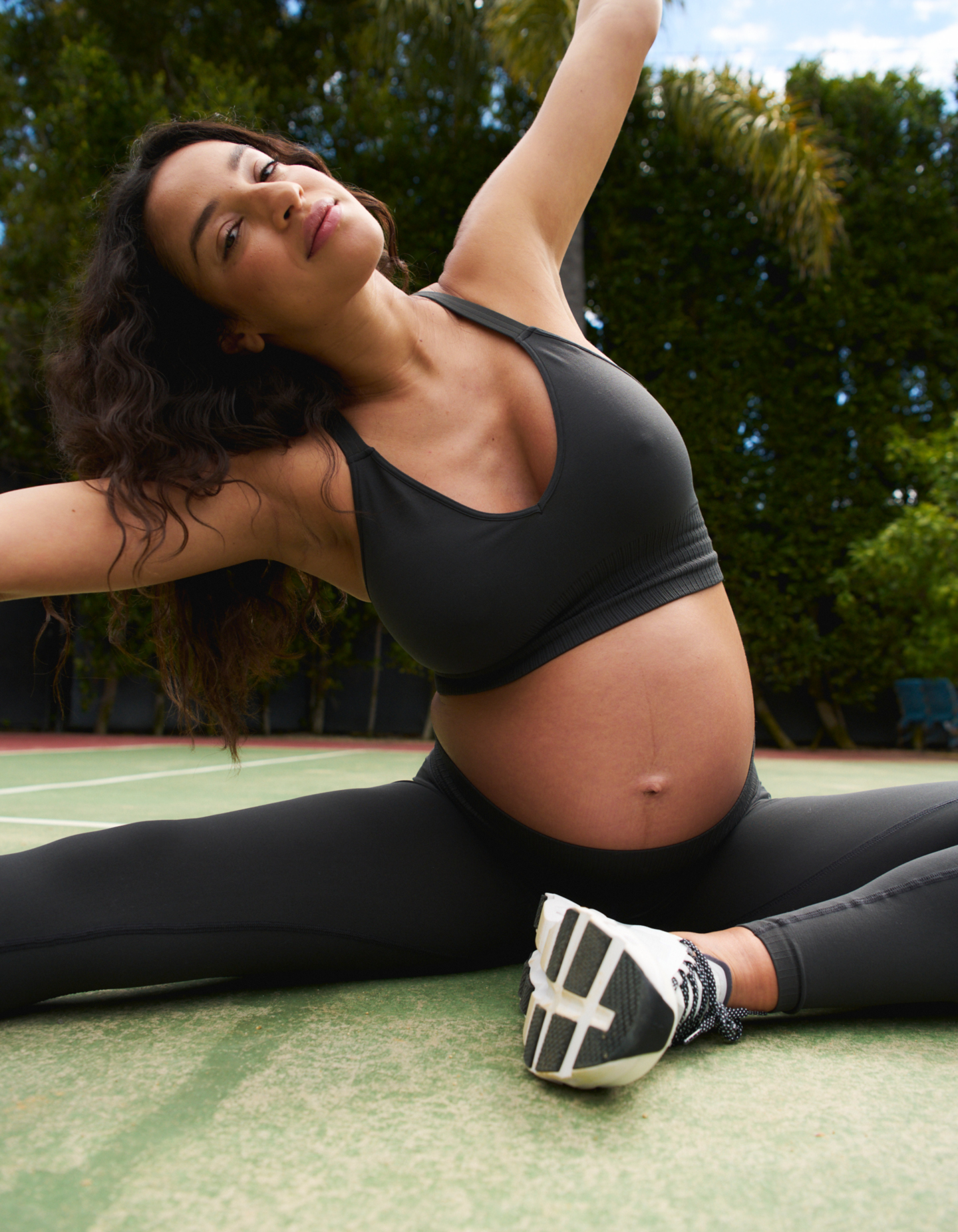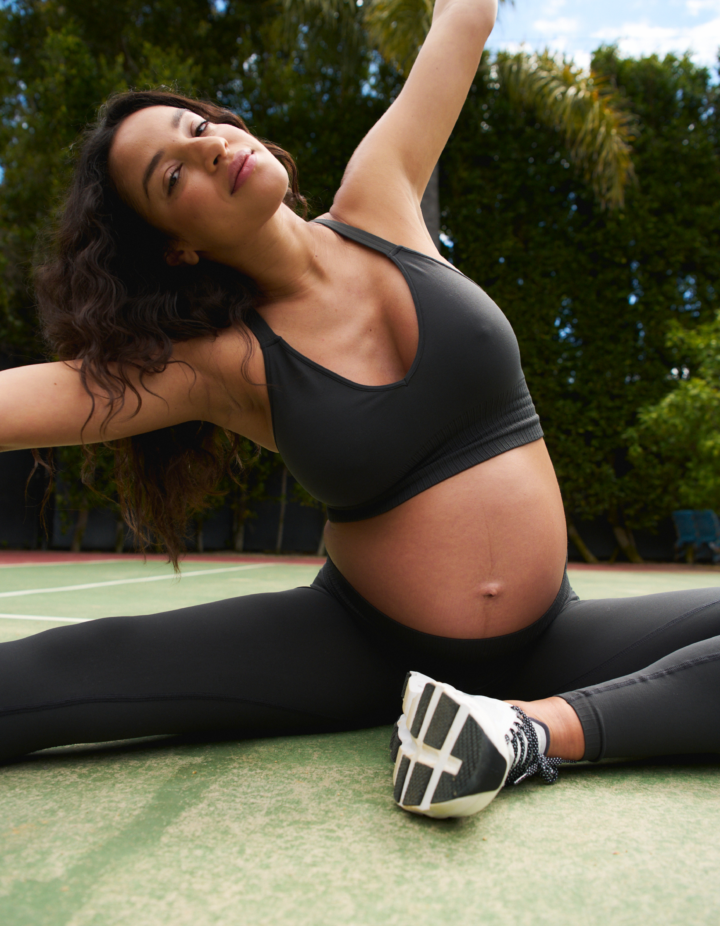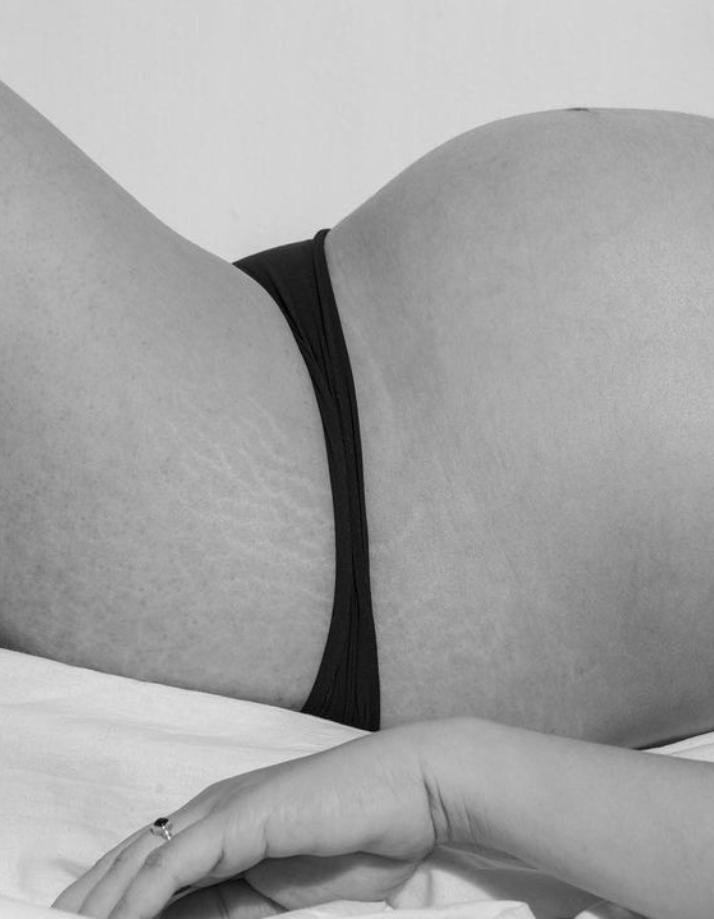Yes, we know. Staying active during (and after) pregnancy comes with a motherlode of science-backed benefits. Better mood, more quality sleep, smoother labor, more strength for the demands of motherhood, pain relief… you name it. But while taking a prenatal or postnatal Pilates class here and there can deliver some perks, you’ll get way more bang for your buck if you stop working out and start training instead.
But wait, isn’t that the same thing? While some use the two terms interchangeably, they’re very different—and have distinctive use cases.
The TL;DR is that working out is all about the immediate. It’s movement or exercise that maintains your fitness today. But when you train, you work towards a specific goal, manipulating variables along the way to see and feel tangible changes in body and mind. With the same amount of weekly time, training will get you way further than working out because there’s a rhyme and reason to what you’re doing.
Getting ready for motherhood or embarking on your postpartum journey are big life moments. Ones where your body, mind, and emotions all change a lot. Doing a workout here and there will offer stress relief, but training can help you become stronger than you ever were before, not just get back to where you were pre-pregnancy. Above all, it empowers you to feel your best and be fully prepared for the new chapter in your life.
Not sure where to start? Our friends at obé Fitness has you covered. To support women on every step of their pregnancy journey, they’ve recently launched two first-of-their-kind workout programs: Prenatal Training and Postnatal Training. Here, NASM CPT + PROnatal Pre/Postnatal Certified obé instructors, Melody D. and Nicole U., share a definitive guide to training through pregnancy—and beyond.
Prenatal Training: Why Do It?
‘Scared to work out while pregnant,’ ‘Is it safe to exercise pregnant, ‘Does exercise cause miscarriage.’ These are just some of the suggested Google searches that pop up on the hunt for safe pregnancy workouts. Between all the contradictory info, being a little (or a lot) scared, navigating physical changes, plus limited education and resources—it’s not shocking most moms-to-be avoid it.
According to one 2015 study, nearly 60% of pregnant women avoid physical activity. The why? Almost 50% report they didn’t get enough information or counseling from healthcare professionals. It turns out that very few healthcare professionals are trained in exercise guidelines, impacting their ability to advise those going through pregnancy.
The facts are that exercising during this time—with the right modifications—comes with an overwhelming amount of research-backed benefits for both mom and baby. Prenatal exercise can reduce the incidence of hypertension, cesarean births, preterm birth, and gestational diabetes, according to the American College of Obstetricians and Gynecologists (ACOG). Not to mention, it can reduce pregnancy pains, lower the risk of postpartum depressive disorders, and aid postpartum recovery time.
So, how do you train for two—safely and confidently?
obé Prenatal Training Program
Cue obé’s expert-curated Prenatal Training, a 4-week, beginner-friendly workout program designed to safely train you through all four trimesters. (To give it a try, Babe readers can enjoy a free month of obé with code BABEMONTH.)
On the weekly lineup: A 10-minute Prenatal Core class (360 breathing and pelvic floor exercises included), a 28-minute Lower Body Strength, a 28-minute Upper Body Strength, and a 28-minute Full Body Sculpt. If you’re up for it, go for active recovery (like stretching, Walks, or Yoga) or any obé cardio of your choice between training days. And for ease of mind, your instructors are a) PROnatal certified fitness experts and b) pregnant themselves.
Unlike other pregnancy workout programs, obé’s Prenatal Training is designed around ‘progressive overload,’ a training principle that consistently delivers strength gains and fitness results. Each of these classes safely and slowly builds in complexity over time, gradually challenging your body so you can adapt. All you have to do is show up, no guesswork included.
“Pregnancy is not a time to stop training,” says Melody. “You don’t need to stop improving your strength or making fitness gains.” By training your muscles (not just working out), you’ll feel relief from pregnancy aches, build muscular endurance for labor and beyond, plus feel confident moving your changing body.
Getting into the details, you’ll also learn how to properly exercise your pelvic floor, work your core (with the right modifications, working your core is totally safe), and move weight around.
“As you go through pregnancy, your body needs to be able to carry a significant amount of load,” explains Melody. “The second we scale back on weight-bearing activities, we’re doing ourselves a disservice. The more we train to support our muscles and joints, the better.”
To supplement your training, you’ll also find a weekly expert Audio Talk (because education is everything). Expect expert intel on prenatal training (demystifying what’s ‘safe’ during pregnancy), nutrition, stress management, mindfulness, and best sleep practices. At obé, we love a holistic approach!
Postnatal Training: Why Do It?
Now, let’s talk about working out post-baby. Most new moms have a lot of questions. Is there a right time to start? What exercises are safe? How long should you wait to recover? Should you prioritize strength or cardio? The list goes on.
Following an expert-curated postnatal training program can ease your mind and provide clarity about what you should do for your body (hint: it’s not always “working out”!).
Point blank; postnatal training is more effective at rebuilding back physical strength than if you just did workouts à la carte. Why? Again, progressive overload is the secret ingredient! When following a program, you know every class is thoughtfully designed to gradually level up, so you can safely progress from your baseline to new supermom strength.
“Most women don’t realize how much they’re going to use their muscles even on that first day after giving birth,” Nicole explains. “Whether you’re using your abs to go from a reclined to an upright position, using your thighs to squat down and pick up a baby, or using your arms to hold them up, you’ll be tapping into your muscles daily.” Without proper training—like knowing the right way to engage your core—you can develop an injury or feel your body taking a toll, she adds.
obé Postnatal Training: Phase 1—Rehab & Recovery
We know the postnatal journey isn’t linear and that every woman has a unique timeline. To honor those individualities, obé’s Postnatal Training program is broken down into two key phases. The first training phase is all about acclimation, rehab, and recovery. Movement here needs to be gentle (but purposeful) to help you settle into your body, which will likely feel different. Don’t think “bounce back,” think “build back stronger.”
“There have been so many shifts with your alignment, energy levels, and muscular atrophy, so it’s super important to ease back into working out,” says Nicole. “You have to give your body the proper time it needs to fully heal before you can take on more strenuous exercise.”
In Phase 1 of obé’s Postnatal Training program, you’ll take on weekly guided walks (optional but recommended!), a mobility + activation class, and a 360 breathing + pelvic floor workout. If you feel ready, you may start this program as early as one week after birth.
Why start here before scaling up to more intense workouts? During pregnancy, the body produces relaxin hormone. Long story short, relaxin enables you to be stretchy and flexible enough to give birth, as its superpower is relaxing your joints and ligaments. The only problem is that it can stay in your body long after pregnancy. Injuring yourself or overstretching can become an issue without proper body awareness.
Plus, you’ll need time to reconfigure the body misalignments from pregnancy—like a tilted pelvis (super common), which can impair your workout form. Training your body to return to a neutral spine and finding vertical alignment is a key investment in your long-term physical health, so don’t rush it.
Finally, Nicole always encourages new moms to listen to their intuition. Repeat this phase as many times as needed before progressing onwards, you may need to go through it 2-3+ times!
obé Postnatal Training: Phase 2—Return to Exercise
Once you feel more confident in your body, it’s time to graduate to Phase 2 of obé’s Postnatal Training program. Here, you’ll build back strength with more traditional workouts and get into a consistent workout habit. Melody and Nicole recommend waiting until at least 6 weeks post-birth to go into this phase of postnatal training.
The main focus here is preparing you for the activities of daily living and motherhood. Each week, you’ll take on a mix of 15-28 minute Sculpt, Strength, and low-impact cardio classes to do just that. Designed to boost the muscles every mom will use, these progressions will repeat for two weeks, then level up in intensity. This progressive overload structure allows you to maintain or build muscle quality, which will diminish aches and pains plus help you move with newfound comfort and stability.
If this seems intimidating, Nicole emphasizes that you’re more ready than you think. “I feel we don’t give moms in the postnatal phase enough credit for what they’re capable of,” she says. “We err on the side of caution so much that it can be fear-provoking. Tap into your intuition, trust your body, and trust your strength.”
Remember, every one of the workouts in this training program was designed to be safe and effective for exactly the stage you’re at. You got this mama, we’re cheering you on.
Ready to start your prenatal or postnatal training journey? Use code BABEMONTH to enjoy one free month of obé—training programs included.




